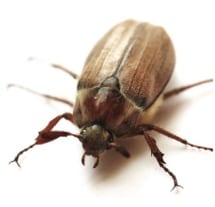
Redheaded Cockchafer
The adult beetle is approximately 13 to 15 mm long and about 8 mm wide and dark brownish-black in colour. The cockchafer grub, which causes lawn damage, is the larval stage of the Redheaded Cockchafer life cycle.
The Redheaded Cockchafer, Adoryphorus couloni (Bermeister), is periodically a common pest, especially in areas of south-west and central Victoria and Gippsland districts. It is also a pest in NSW (particularly in the southern tablelands), South Australia (lower south-east region) and Tasmania (northern area).
Redheaded Cockchafer appears to be a problem in areas where the annual rainfall is greater than 500 mm. The wetter seasons however result in a substantial reduction in their population, possibly due to drowning, disease and being trampled by animals. Redheaded Cockchafers tend to be more prolific on the lighter sandy loams and silty loam soils.
Their body is soft and white-grey in colour when feeding in their earlier growth stages, and becomes white when mature. The older larvae have six yellowish legs and a hard reddish-brown head. Their body wall is transparent. Newly hatched larva are about 5 mm long but grow to 25 to 30 mm long as adults and about 5 mm in diameter.
The Redheaded Cockchafers tend to curl into a C-shape on exposure or when handled. If the blackheaded and redheaded grubs are placed together, the blackheaded are more active.
Young Blackhead Cockchafer grubs can also have reddish heads in their early instar stages and so may be incorrectly identified as Redheaded Cockchafers. The Redheaded Cockchafer has a life cycle of two years, most of it spent underground.
The adult beetles emerge from the soil from late winter to early spring (end of August to early October) and fly at dusk, to mate before egg-laying. The females lay their eggs singly at depths of 10 to 50 mm in the soil under lawn.
If you are unsure which breed of cockchafer has invaded your lawn, the team at Lawn Addicts specialises in grass insect identification – and can recommend the best online lawn care products according to your turf identification.
Message us for further advice about other products.
